- ORA launches its Verifiable Oracle Protocol (VOP) on Ethereum mainnet, enabling decentralized AI integration.
- Expansion plans include deployment on Optimism, Base, Polygon, and Manta in the near future.
- OpML framework empowers on-chain machine learning computations, ensuring verifiability and transparency.
- ORA’s OAO platform offers access to cutting-edge AI models such as Grok, Stable Diffusion, and Llama2.
- OpML’s efficiency reduces overhead costs significantly, making on-chain AI deployment practical and scalable.
Main AI News:
ORA’s blockchain-based AI oracle, now operational on Ethereum’s mainnet, marks a significant milestone for decentralized machine learning integration. This groundbreaking Verifiable Oracle Protocol (VOP) is spearheading a new era of blockchain-powered AI services, promising unparalleled verifiability, validity, and transparency.
The initial deployment on Ethereum is just the beginning; ORA has ambitious plans to expand its reach across various blockchain ecosystems, including Optimism, Base, Polygon, and Manta, in the coming weeks. This strategic expansion aims to maximize accessibility and adoption, ensuring that the benefits of AI integration are widely accessible to developers and users alike.
Integrating machine learning and AI capabilities onto the blockchain has long been hailed as a transformative development. However, it hasn’t been without its challenges. One of the primary obstacles has been the complexity and cost associated with running machine learning computations across decentralized nodes. Ethereum’s computational framework, optimized for smart contracts, posed additional compatibility hurdles for AI-related tasks.
ORA’s innovative solution to this challenge lies in its Optimistic Machine Learning (OpML) framework, tailor-made for Ethereum’s ecosystem. OpML empowers developers to design and deploy machine learning models directly on-chain, leveraging the blockchain’s inherent advantages while mitigating security concerns. By adopting a “verification game” mechanism akin to optimistic rollup systems, OpML ensures decentralized consensus and verifiability for machine learning services.
Upon initiation of an ML service task, results are promptly committed on-chain, initiating a validation process akin to optimistic rollup mechanisms. Any discrepancies trigger a dispute resolution mechanism, ensuring accountability and accuracy in AI-driven services. Notably, ORA’s OAO platform offers access to cutting-edge AI models, including Grok, Stable Diffusion, and Llama2, further enhancing its appeal and utility.
Kartin Wong, ORA’s visionary founder, emphasized the unparalleled capabilities of OpML, particularly in bringing Grok—a generative AI chatbot—onto the blockchain. This strategic advantage underscores ORA’s commitment to pushing the boundaries of decentralized AI integration, cementing its position as a trailblazer in the field.
While alternative approaches like zero-knowledge ML (zkML) have been explored, OpML’s efficiency and scalability set it apart. Unlike zkML, OpML offers a practical solution for on-chain deployment, significantly reducing overhead costs and paving the way for the widespread adoption of sophisticated AI models like Grok.
Conclusion:
ORA’s introduction of its on-chain AI oracle signifies a major advancement in decentralized AI integration. With the OpML framework at its core, ORA is poised to drive innovation and accessibility in the AI market, offering developers and users unprecedented opportunities for collaboration and advancement. This development heralds a new era of decentralized AI services, with potential implications for industries ranging from finance to healthcare. Companies operating in these sectors must stay abreast of these advancements to remain competitive and leverage the benefits of decentralized AI technologies.

